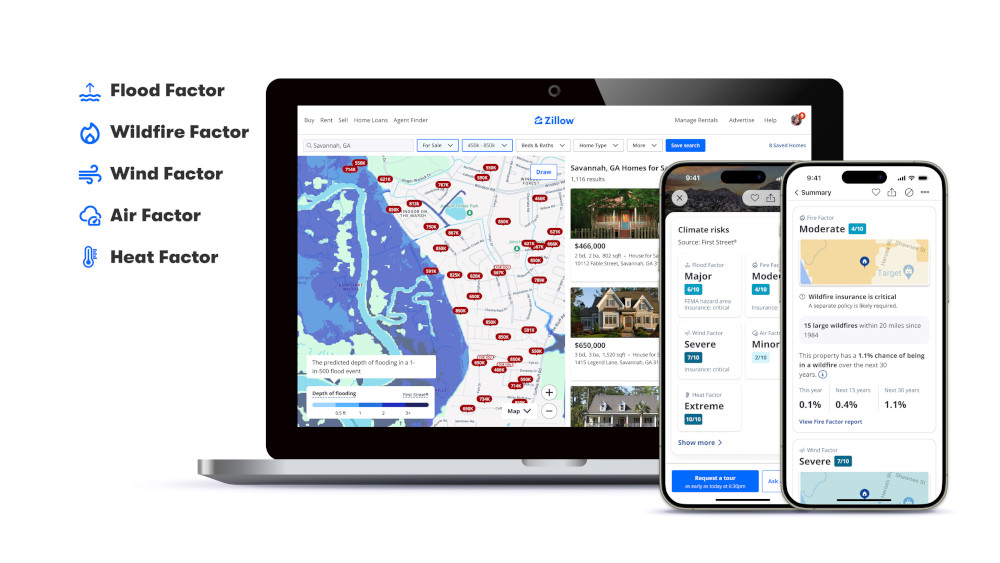US real estate marketplace Zillow® recently
introduced climate-risk data, provided by First
Street — an organization that provides climate-risk
data for properties in the United States — on for-sale property listings across
the US. Home shoppers will gain insights into five key risks — flood,
wildfire, wind, heat and air quality — directly from listing
pages, complete with risk scores, interactive maps and insurance requirements.
In a 2022 survey, 3 in 5 US
adults
said the likelihood of climate-related disasters has already played a role in
deciding where to move or buy a home; a 2023 Zillow study found more than 80
percent of
buyers
now consider climate risks when purchasing a home. Featuring comprehensive
climate-risk data — which fellow online real estate marketplace Redfin began
doing in
2021
— provides a clearer understanding of potential hazards, helping buyers to
better assess long-term affordability and plan for the future. Zillow also now
features tailored insurance recommendations alongside detailed historical
insights — showing if or when a property has experienced past climate events,
such as flooding or wildfires.
"Climate risks are now a critical factor in home-buying decisions," said Skylar
Olsen, chief economist at
Zillow. "Healthy markets are ones where buyers and sellers have access to all
relevant data for their decisions. As concerns about flooding, extreme
temperatures and wildfires grow — and what that might mean for future insurance
costs — this tool also helps agents inform their clients in discussing climate
risk, insurance and long-term affordability."
Navigating climate-risk scores on Zillow
 Image credit: Zillow
Image credit: Zillow
When using Zillow's search map view, home shoppers can explore climate-risk
data through an interactive map highlighting the five key risk categories —
which are each color-coded and have their own color scale, according to the
severity of risk.
When viewing a for-sale property on Zillow, home shoppers will see a new
climate-risk section that includes a separate module for each risk category —
featuring detailed, property-specific data. This section not only shows how
these risks might affect the home now and in the future; it also provides
crucial information on wind, fire and flood insurance requirements.
According to a Zillow
analysis conducted
in August, more new US listings come with major climate risk compared to homes
listed for sale five years ago — across all five of the climate-risk categories
analyzed. Across all new listings in August, 16.7 percent were at major risk of
wildfire, while 12.8 percent came with a major risk of flooding.
Partnership with First Street
First Street's models, developed by scientists and vetted through a
peer-review process, are used across industries including real estate, banking,
government and insurance — ensuring that the climate insights given on Zillow
are both credible and actionable.
First Street's analysis of the impact of found 78 percent of properties flooded
by Hurricane
Debby this
summer were outside FEMA flood zones, and consequently located where flood
insurance isn't mandatory. 85 percent of these properties would have qualified
for Zillow’s new insurance recommendation, highlighting how climate-risk data
can guide users in assessing insurance needs and making informed decisions about
their future homes.
"At First Street, we are on a mission to connect climate change to financial
risk," said First Street founder and CEO Matthew
Eby. "Partnering with Zillow helps us
achieve that mission by providing the millions of everyday users on the Zillow
platforms with the same property-specific climate-risk data that is used by top
banks, agencies and investors."
Zillow's own climate plans
In addition to expanding its suite of tools and data to address
climate-related challenges, Zillow is also taking steps to reduce its own
environmental footprint. The Science Based Targets initiative (SBTi) recently
validated
Zillow's near-term science-based targets for reducing greenhouse gas (GHG)
emissions, which are:
-
To reduce Zillow's absolute scopes 1 and 2 GHG emissions 94 percent by 2030
from a 2019 base year.
-
For 75 percent of the company's suppliers to have science-based targets for
emissions reductions covering procured goods and services, capital goods and
business travel by 2028.
Climate-risk information will be available on the Zillow app for iOS® and on
the Zillow website by the end of the year, with Android™ availability
expected early next year.
Get the latest insights, trends, and innovations to help position yourself at the forefront of sustainable business leadership—delivered straight to your inbox.
Sustainable Brands Staff
Published Oct 21, 2024 8am EDT / 5am PDT / 1pm BST / 2pm CEST